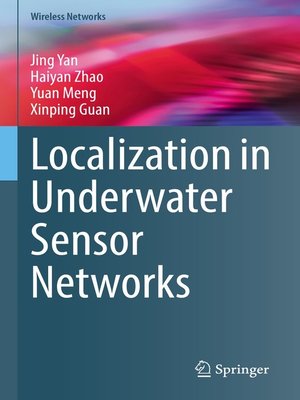
Sign up to save your library
With an OverDrive account, you can save your favorite libraries for at-a-glance information about availability. Find out more about OverDrive accounts.
Find this title in Libby, the library reading app by OverDrive.



Search for a digital library with this title
Title found at these libraries:
| Library Name | Distance |
|---|---|
| Loading... |
Ocean covers 70.8% of the Earth's surface, and it plays an important role in supporting all life on Earth. Nonetheless, more than 80% of the ocean's volume remains unmapped, unobserved and unexplored. In this regard, Underwater Sensor Networks (USNs), which offer ubiquitous computation, efficient communication and reliable control, are emerging as a promising solution to understand and explore the ocean. In order to support the application of USNs, accurate position information from sensor nodes is required to correctly analyze and interpret the data sampled. However, the openness and weak communication characteristics of USNs make underwater localization much more challenging in comparison to terrestrial sensor networks.
In this book, we focus on the localization problem in USNs, taking into account the unique characteristics of the underwater environment. This problem is of considerable importance, since fundamental guidance on the design and analysis ofUSN localization is very limited at present. To this end, we first introduce the network architecture of USNs and briefly review previous approaches to the localization of USNs. Then, the asynchronous clock, node mobility, stratification effect, privacy preserving and attack detection are considered respectively and corresponding localization schemes are developed. Lastly, the book's rich implications provide guidance on the design of future USN localization schemes.
The results in this book reveal from a system perspective that underwater localization accuracy is closely related to the communication protocol and optimization estimator. Researchers, scientists and engineers in the field of USNs can benefit greatly from this book, which provides a wealth of information, useful methods and practical algorithms to help understand and explore the ocean.
In this book, we focus on the localization problem in USNs, taking into account the unique characteristics of the underwater environment. This problem is of considerable importance, since fundamental guidance on the design and analysis ofUSN localization is very limited at present. To this end, we first introduce the network architecture of USNs and briefly review previous approaches to the localization of USNs. Then, the asynchronous clock, node mobility, stratification effect, privacy preserving and attack detection are considered respectively and corresponding localization schemes are developed. Lastly, the book's rich implications provide guidance on the design of future USN localization schemes.
The results in this book reveal from a system perspective that underwater localization accuracy is closely related to the communication protocol and optimization estimator. Researchers, scientists and engineers in the field of USNs can benefit greatly from this book, which provides a wealth of information, useful methods and practical algorithms to help understand and explore the ocean.







